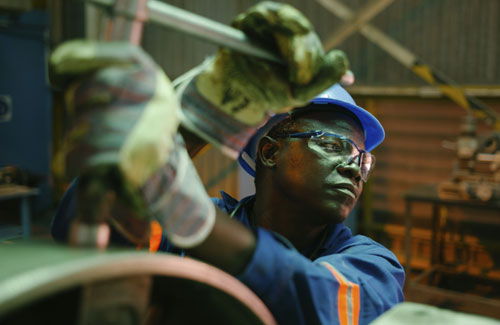Anglo American announced interim results for the six months that ended 30th June, 2020 and noted that De Beers’ total revenue decreased by 54% year-on-year to $1.2 billion, with rough diamond sales falling to $1.0 billion versus $2.3 billion last year. Rough diamond sales volumes decreased by 45% to 8.5 million carats due to the significant impact of Covid-19 on the global diamond industry, the company noted.
Consequently, De Beers offered sightholders the option to defer up to 100% of their allocations at the fourth and fifth sights and held some viewings for sight 5 outside of Botswana, following the cancellation of the third sight of 2020 due to Covid-19 related travel restrictions. The average realised price decreased by 21% to $119/carat, driven by a higher proportion of lower value rough diamonds being sold in the first two sights of the year and an 8% decline in the average rough price index.
Underlying earnings before interest, tax, depreciation and amortisation (EBITDA) decreased to $2 million from $518 million a year ago owing to the impact of the considerably lower sales volumes and the lower rough price index reducing margins in both the mining and the trading businesses. Unit costs were flat compared with the first half of 2019 due to cost-saving measures and favourable exchange rates.
Anglo noted that all parts of the diamond supply chain were severely impacted by the global lockdown measures introduced in response to the Covid-19 pandemic in the first half of 2020.
After a strong US holiday season at the end of 2019, the rough diamond industry started 2020 positively as the midstream restocked and sentiment improved. However, from February, the Covid-19 outbreak began to have a significant impact on diamond jewellery retail sales and supply chain. Jewellery retailer restocking has therefore been very limited, with many jewellers suspending all polished purchases and/or delaying payments to their suppliers.
In addition to the impact on consumer markets, most of the Indian and southern African diamond cutting and polishing centres closed due to the lockdown restrictions. A gradual opening of diamond cutting and polishing centres started at the end of May; however, Covid-19 restrictions have remained in place, particularly in India, limiting capacity. De Beers and other major suppliers increased flexibility in response to this lower demand.
Rough diamond sales have also been materially affected by lockdowns and travel restrictions, delaying the shipping of rough diamonds into cutting and trading centres and preventing buyers from attending sales events.
China has seen strong diamond jewellery sales post-lockdown, with sales for May and June above those for the comparable periods last year. Recovery in the US will be dependent on the re-opening of its economy.
De Beers’ H1 rough diamond production decreased by 27% to 11.3 million carats, primarily due to the Covid-19 lockdowns in southern Africa. Mining operations restarted following the easing of regional lockdowns, with Covid-19 measures in place to safeguard the workforce; however, production resumed at lower levels, reflecting reduced demand for rough diamonds as a consequence of the pandemic.
In Botswana, H1 production was 36% lower at 7.5 million carats. Production for the six-month period at Jwaneng fell by 34% to 4.3 million carats due to the shutdown.
In Namibia, half yearly production increased by 6% to 0.9 million carats, driven by the marine operations as the Mafuta crawler vessel was under planned maintenance in the second quarter of 2019, and supported by the implementation of measures to enable continuity of the fleet while safeguarding the workforce.
In South Africa, production increased by 37% at Venetia to 1.3 million carats, supported by a significant increase in grade as the final ore from the open pit is mined prior to the transition to underground, partially offset by the lockdown.
Canadian H1 production decreased by 23% to 1.6 million carats.
Jewellery retail stores were significantly affected by Covid-19, with the majority of De Beers Jewellers (DBJ) stores and Forevermark outlets closed across key markets for a considerable part of the reporting period. Stores have re-opened following the gradual lifting of lockdowns, but remain at risk of temporary closure in response to second-wave concerns.
Mainland China has shown signs of a strong recovery as stores have returned to normal operating hours. DBJ has delivered double-digit year-on-year sales growth here in the year-to-date, with a similar recovery reported by Forevermark at its Mainland China locations in recent months. Hong Kong remains subdued.
De Beers said the current market outlook is highly uncertain owing to the possibility of a second wave of Covid-19 infections, the ability of fiscal and monetary measures to continue to support employment and businesses in consumer countries, as well as the shape and strength of the global macro-economic recovery. Significant challenges for rough diamond demand look set to continue in the short term with the ongoing restrictions to travel in southern Africa, as well as the risk of further Covid-19 cases in the Indian cutting centres.
“In the longer term, the outlook for the diamond sector remains positive, and De Beers is accelerating its business transformation – from discovery and mining, to how we sell rough diamonds to customers and how consumers purchase diamond jewellery – to ensure it retains its prime position as the world’s leading diamond business,” the company said.
De Beers left its full-year production guidance unchanged at 25-27 million carats, subject to continuous review based on Covid-19 operational disruptions, as well as the timing and scale of the recovery in demand.

